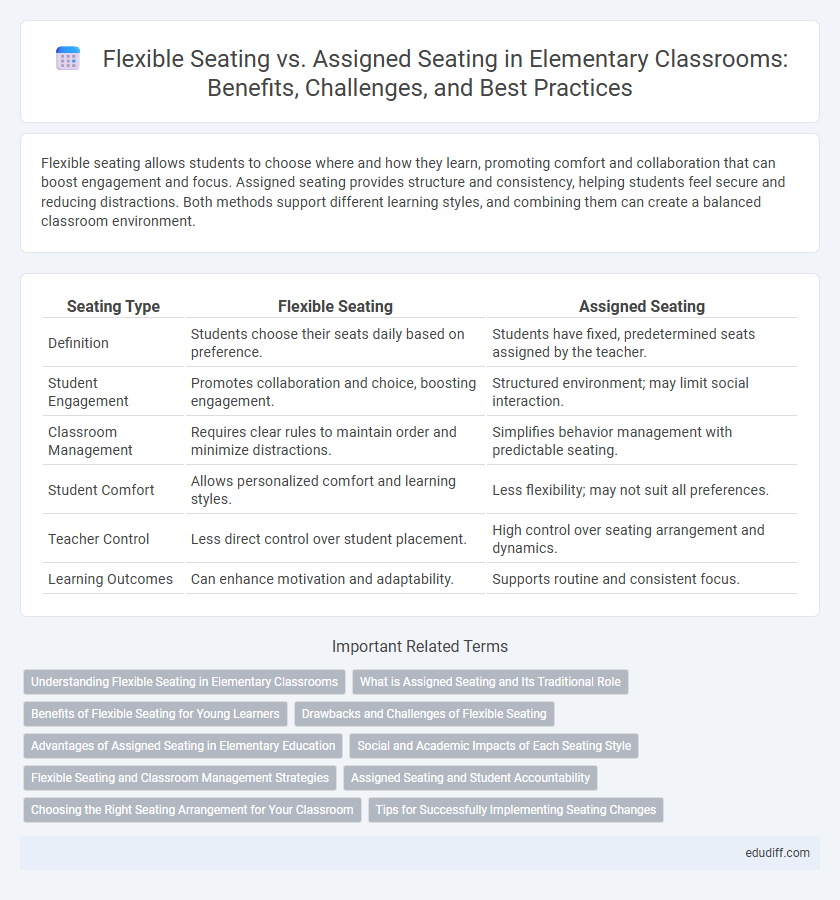Flexible seating allows students to choose where and how they learn, promoting comfort and collaboration that can boost engagement and focus. Assigned seating provides structure and consistency, helping students feel secure and reducing distractions. Both methods support different learning styles, and combining them can create a balanced classroom environment.
Table of Comparison
| Seating Type | Flexible Seating | Assigned Seating |
|---|---|---|
| Definition | Students choose their seats daily based on preference. | Students have fixed, predetermined seats assigned by the teacher. |
| Student Engagement | Promotes collaboration and choice, boosting engagement. | Structured environment; may limit social interaction. |
| Classroom Management | Requires clear rules to maintain order and minimize distractions. | Simplifies behavior management with predictable seating. |
| Student Comfort | Allows personalized comfort and learning styles. | Less flexibility; may not suit all preferences. |
| Teacher Control | Less direct control over student placement. | High control over seating arrangement and dynamics. |
| Learning Outcomes | Can enhance motivation and adaptability. | Supports routine and consistent focus. |
Understanding Flexible Seating in Elementary Classrooms
Flexible seating in elementary classrooms promotes student engagement by allowing children to choose where and how they learn, such as using wobble stools, bean bags, or standing desks. This approach supports diverse learning styles, encourages collaboration, and helps improve focus by providing a comfortable and dynamic environment. Research shows that flexible seating can boost student motivation, leading to better academic outcomes and classroom behavior.
What is Assigned Seating and Its Traditional Role
Assigned seating in elementary classrooms involves designating specific seats to each student, promoting structure and predictability. This traditional approach supports classroom management by reducing distractions and making attendance tracking easier. Teachers can strategically place students to optimize learning dynamics and address individual needs.
Benefits of Flexible Seating for Young Learners
Flexible seating in elementary classrooms enhances student engagement by allowing young learners to choose seating that suits their learning style and comfort. This approach promotes collaboration and social skills development through varied seating arrangements like floor cushions, standing desks, and bean bags. Research shows that flexible seating reduces behavioral issues and improves focus, leading to higher academic achievement and positive classroom climate.
Drawbacks and Challenges of Flexible Seating
Flexible seating in elementary classrooms can lead to distractions as students may struggle to focus in less structured environments. Managing classroom behavior and ensuring equitable seat choice often pose challenges for teachers. Additionally, flexible seating requires significant time and resources to reorganize and maintain daily.
Advantages of Assigned Seating in Elementary Education
Assigned seating in elementary education promotes classroom management by reducing distractions and minimizing student conflicts, creating a structured learning environment. It supports teachers in monitoring student behavior and academic progress effectively by knowing exactly where each child is seated. Furthermore, assigned seating helps accommodate diverse learning needs, ensuring that students receive appropriate support based on their individual strengths and challenges.
Social and Academic Impacts of Each Seating Style
Flexible seating fosters collaboration and social interaction among elementary students, promoting communication skills and peer learning. Assigned seating provides structure that can reduce distractions and support focused academic performance, especially for students who need consistency. Balancing both seating styles can address diverse learning needs while enhancing social development and academic engagement.
Flexible Seating and Classroom Management Strategies
Flexible seating in elementary classrooms promotes student engagement and autonomy by allowing learners to choose seating that suits their learning style, which can improve focus and behavior. Effective classroom management strategies for flexible seating include establishing clear rules, creating designated zones for different seating options, and teaching students how to collaborate respectfully. Implementing these practices helps maintain order while supporting personalized learning environments.
Assigned Seating and Student Accountability
Assigned seating in elementary classrooms promotes student accountability by establishing clear expectations and consistent routines. This structured environment helps students take responsibility for their behavior and learning by minimizing distractions and encouraging focus. Teachers can better monitor attendance, participation, and interactions, fostering a disciplined and orderly classroom.
Choosing the Right Seating Arrangement for Your Classroom
Flexible seating options encourage student collaboration and increase engagement by allowing movement and choice, which supports diverse learning styles. Assigned seating can offer structure and minimize distractions, helping manage classroom behavior effectively. Selecting the right seating arrangement depends on your instructional goals, student needs, and classroom dynamics to create an optimal learning environment.
Tips for Successfully Implementing Seating Changes
Create clear guidelines and communicate expectations to students to ensure a smooth transition from assigned seating to flexible seating in elementary classrooms. Incorporate a variety of seating options such as stools, cushions, and floor seating to accommodate different learning styles and promote comfort. Regularly assess and adjust the seating arrangements based on student feedback and engagement levels to maintain an effective and dynamic learning environment.
Flexible Seating vs Assigned Seating Infographic

 edudiff.com
edudiff.com